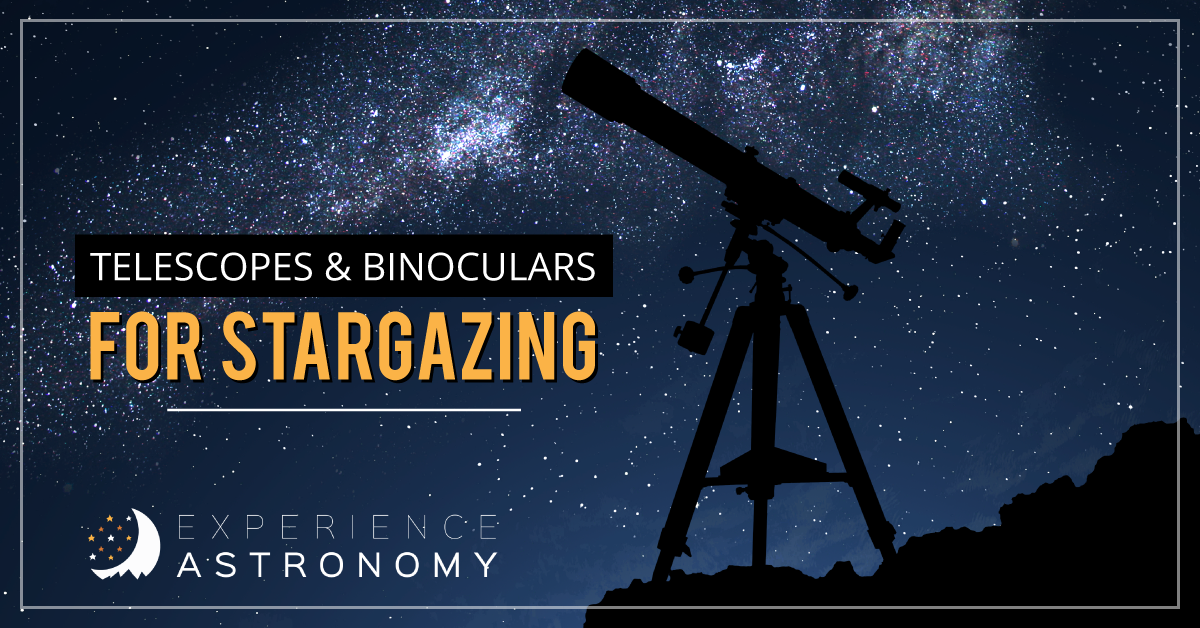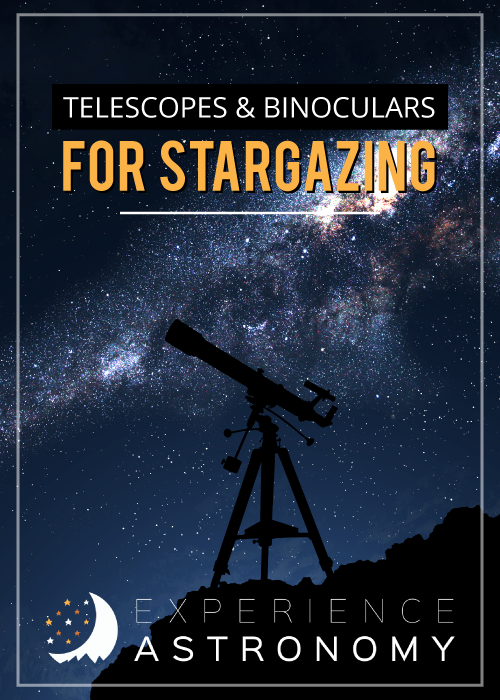If you want to explore the sky, a telescope or binoculars for stargazing can make all of the difference!
When new students register for our online astronomy courses, one of the first questions they ask me is if I can recommend a good telescope. Our courses do not require use of a telescope—as that could make them cost-prohibitive for many families—but some students and parents still want a nice telescope to explore the sky.

Stargazing Binoculars or Telescope…Which Is Better?
Here’s the thing: a good hobbyist telescope is often fairly expensive (around $500-$2000) and involves a big learning curve. If your thoughts on telescopes are “go big or go home,” then you’re not only going to need to fork over a lot of cash on the telescope and all the extras (power tank, carrying bag, scope, GPS, computer, etc.), but you’re also committing to learning how it works.
Is a hobbyist telescope cool? You bet. Does it take a lot of money and time? Absolutely.
Binoculars, on the other hand, are far more affordable than telescopes, are easy to use, and work great for stargazing.
So which one is best: stargazing binoculars or a telescope? It really depends on your needs! If you have the budget and time to devote to a telescope and know you’ll be using it a lot, go for it! Otherwise, binoculars for stargazing are a great place to get started.
But, if you’re still not sure, we’ve laid out the pros and cons of each to help you decide which choice is best for your astronomy experience.
The Best Telescopes for Stargazing
The Best Hobbyist Telescopes
A hobbyist telescope is an intermediate telescope that is best for those who plan to use their telescope regularly. Below are a few of our favorites:
The Best Telescope for Kids
Another option is to go with a kids’ telescope. This is definitely less expensive (most are less than $100). The issue with these is you don’t always see a whole lot with them. If you’re looking for a good first-time telescope for your littles, here are our recommendations for kiddos:
- Celestron – 76mm Signature Series FirstScope
- Celestron Astro Fi 102 Wi-Fi Maksutov Wireless Reflecting Telescope
- Educational Insights GeoSafari Omega Refractor Telescope (for 10 and up)
- Celestron AstroFi 90 Wi-Fi Refractor Wireless Refracting Telescope (for 10 and up)
The Best Telescopes for Beginners
If you’re looking to dive deeper into your use of a telescope (beyond just a hobby), you’re going to want a decent amateur telescope. These are moderately priced ($300-$500) and are actually easier to use than a hobbyist telescope. The best telescope for beginners who want to someday be more than an amateur can be chosen from our list of recommendations below.
- Celestron AstroFi 102 Wi-Fi Maksutov Wireless Reflecting Telescope
- Celestron Inspire 100AZ Refractor Telescope
- CELESTRON StarSense Explorer DX 130AZ Smartphone App-Enabled Telescope
The Best Astronomy Binoculars
If you’re looking for something good for both parents and kids, we recommend getting a good pair of astronomy binoculars.
Why binoculars?
- You’re using both eyes. This gives your brain a better view of the objects you see.
- The images are right-side-up. Telescopes (because they often use mirrors) invert the images you see, but what you see in binoculars is more intuitive as far as comparing what you see to a map of the sky.
- Kids find them easier to use—if you’ve ever asked a kid to close one eye and line up their other eye just the right place in a telescope eye-piece, you know what I’m talking about.
- There is little-to-no learning curve.
- There’s almost no set-up and take-down time. This is great for those cold nights when you just want a quick glance at the sky.
- Binoculars are versatile. If you ever want to use them for bird-watching or other nature-viewing, they can be used for that as well.
- They are often cheaper.
What strength binoculars do I need for stargazing?
Standard sky-viewing binoculars are 7-power—the same power used by the military today—and this would be good for a first-time buyer. But if you can find a 10 or 15 power, these will magnify things wonderfully!
The Best Binoculars for Stargazing
Find a good store that carries binoculars so you can try them out—how they feel in your hands, how they feel on your eyes, etc.—and see which one has a good balance of price and performance. Here are a few binoculars for stargazing that we recommend you try out:
- Celestron SkyMaster Giant 15×70 Binoculars with Tripod Adapter
- Nikon Monarch HG 10 x 42 Binoculars
- BARSKA Gladiator 20-100×70 Zoom Binocular w/Tripod Adapter
Make sure, whatever you buy, you also get a tripod to go with the binoculars. This will keep your image steady.
For more information about how to use binoculars for stargazing, check out these articles by Earth and Sky and Sky and Telescope.

Your Kids Can Learn Astronomy!
If your child loves learning about the stars, they will love Experience Astronomy Elementary, Experience Astronomy (Junior High), or Experience Astronomy PLUS (High School).
We cover so much in these full-school-year online courses. Students learn about…
- How to identify major constellations
- Ways astronomy connects to fascinating stories in history, literature, folklore, archaeology, and the Bible
- The amazing world of interstellar space—stars, galaxies, black holes, and exoplanets
- How ancient people used astronomy to tell time, create calendars, and navigate the globe
Best yet: I do all the teaching for you through fun, engaging online videos and hands-on activities. And, your student can use their stargazing binoculars or telescope as they follow our course materials!
Experience Astronomy: Elementary
Experience Astronomy (Junior High)
Experience Astronomy PLUS (High School)

